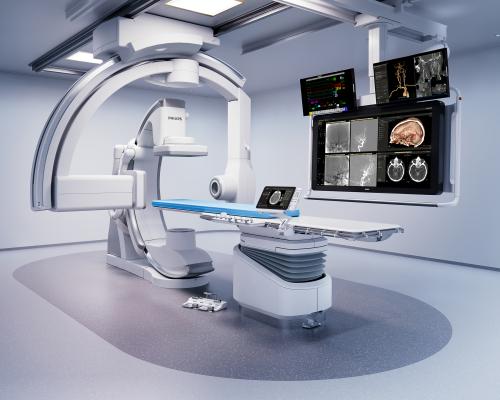
February 28, 2024 — Royal Philips, a global leader in health technology, announced major enhancements to its Image Guided Therapy System – Azurion – with the launch of its new Azurion neuro biplane system. Designed to improve productivity and help care teams make the right decisions faster, treat more patients, and achieve better outcomes, the new interventional system features enhanced 2D and 3D imaging and X-ray detector positioning flexibility.
Minimally invasive procedures are a key part of the diagnosis and treatment pathway for stroke, where every minute counts in conserving the patient’s quality-of-life. Interventional systems are also used to precisely plan and carry out complex neurovascular procedures such as the repair of brain aneurysms and birth defects. By allowing neuro interventionists to treat more patients, more efficiently, with potentially better outcomes, the new Philips Azurion neuro biplane system enhances both the staff and patient experience and contributes to lower cost of care.
“Working closely with leading interventionists, we designed the latest Azurion neuro biplane to meet their requirements of superior patient care, optimized angio suite performance, and efficient return on investment,” said Mark Stoffels, Business Leader of Image Guided Therapy Systems at Philips. “Together, I am confident we can continue to reduce the impact of stroke, helping more patients to recover faster and reducing long-term impact on their health.”
Philips’ Azurion neuro biplane image-guided therapy system is designed to smooth and optimize procedure workflows where a combination of 2D and 3D imaging is needed for confident diagnosis and precision treatment. Used with the company’s latest Neuro Suite software and services, itprovides neuro interventionists with a fully integrated solution that combines Philips’ world-class ClarityIQ low dose imaging with a range of neuro dedicated tools* and value-added services that offer unprecedented levels of efficiency, flexibility, and control.
New features in the Azurion neuro biplane system include enhanced C-arm rotation, angulation (imaging angles), and parking facilities that allow rapid transitioning between 2D to 3D imaging, comprehensive table-side control that eliminates the need to leave the sterile field, automatic beam rotation to obtain correctly oriented images for every angulation and rotation, and a new head immobilizer to support enhanced stroke care.
Accelerating treatment for stroke
One in four adults over the age of 25 will have a stroke at some point in their lives [1]. Globally, the direct and indirect cost has been estimated at around USD 891 billion per year [2]. The key to reducing the personal, societal, and financial impact of stroke is to follow the axiom ‘time-is-brain’. The faster stroke is treated, the better the potential outcome.
For ischemic stroke, which accounts for 87% of all strokes [3], the benefits of delivering intra-arterial treatment (IAT) – catheter-based procedures to mechanically disrupt or remove blood clots (mechanical thrombectomy) and/or inject clot-busting agents – within 6 hours of symptom onset, are widely accepted [4]. With mechanical thrombectomy becoming the standard for treating large vessel occlusion (LVO) ischemic stroke, the demand for high utilization angio suites that allow interventionists to operate with speed and efficiency has rapidly increased.
In addition to the efficiency enhancing features of its Azurion platform, Philips is maximizing the up-time of its angio suite solutions by using AI and machine learning to monitor system performance through the new remote connection services of the Philips ServiceHub. These services communicate, monitor, and proactively respond to potential service issues – for example, predicting likely component failures at least 7 days in advance so that pre-emptive action can be taken.
With its comprehensive stroke care portfolio, Philips is connecting the dots between caregivers – wherever they are – at every vital step in the stroke care pathway. The result is smart stroke solutions designed to support connected care.
For more information: www.philips.com
References:
*SmartCT Soft Tissue, SmartCT Angio, SmartCT Roadmap, SmartCT Vaso, AneurysmFlow
[1] World Stroke Organization (WSO): Global Stroke Fact Sheet 2022 (https://www.world-stroke.org/assets/downloads/WSO_Global_Stroke_Fact_Sheet.pdf)
[2] Owolabi MO, Thrift AG, Mahal A, et al.; Stroke Experts Collaboration Group. Primary stroke prevention worldwide: translating evidence into action. Lancet Public Health. 2022 Jan;7(1):e74-e85. doi: 10.1016/S2468-2667(21)00230-9. Epub 2021 Oct 29. Erratum in: Lancet Public Health. 2022 Jan;7(1):e14. PMID: 34756176; PMCID: PMC8727355. https://www.thelancet.com/journals/lanpub/article/PIIS2468-2667(21)00230-9/fulltext
[3] Virani S.S., Alonso A., Benjamin E.J., et al. Heart Disease and Stroke Statistics-2020 Update: A Report from the American Heart Association. Circulation. 2020;141:e139–e596. doi: 10.1161/CIR.0000000000000757. https://www.ahajournals.org/doi/full/10.1161/CIR.0000000000000757?rfr_dat=cr_pub++0pubmed&url_ver=Z39.88-2003&rfr_id=ori%3Arid%3Acrossref.org
[4] NHS England UK : https://www.england.nhs.uk/wp-content/uploads/2019/05/Mechanical-thrombectomy-for-acute-ischaemic-stroke-ERRATA-29-05-19.pdf
[5] WE-TRUST (Workflow Optimization to Reduce Time to Endovascular Reperfusion for Ultra-fast Stroke Treatment). Sponsored by Philips. https://www.wetrust-study.com/


 April 24, 2024
April 24, 2024 








